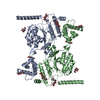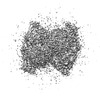[English] 日本語
 Yorodumi
Yorodumi- EMDB-24785: Cryo-EM structure of human GlcNAc-1-phosphotransferase A2B2 subcomplex -
+ Open data
Open data
- Basic information
Basic information
| Entry |  | |||||||||
|---|---|---|---|---|---|---|---|---|---|---|
| Title | Cryo-EM structure of human GlcNAc-1-phosphotransferase A2B2 subcomplex | |||||||||
 Map data Map data | ||||||||||
 Sample Sample |
| |||||||||
 Keywords Keywords | GlcNAc-1-phosphotransferase / lysosomal hydrolases / mannose 6-phosphate trafficking pathway / TRANSFERASE | |||||||||
| Function / homology |  Function and homology information Function and homology informationUDP-N-acetylglucosamine-lysosomal-enzyme N-acetylglucosaminephosphotransferase / N-glycan processing to lysosome / UDP-N-acetylglucosamine-lysosomal-enzyme N-acetylglucosaminephosphotransferase activity / secretion of lysosomal enzymes / carbohydrate phosphorylation / lysosome organization / Golgi membrane / calcium ion binding / Golgi apparatus Similarity search - Function | |||||||||
| Biological species |  Homo sapiens (human) Homo sapiens (human) | |||||||||
| Method | single particle reconstruction / cryo EM / Resolution: 3.3 Å | |||||||||
 Authors Authors | Li H | |||||||||
| Funding support |  United States, 1 items United States, 1 items
| |||||||||
 Citation Citation | Journal: Nat Struct Mol Biol / Year: 2022 Title: Bound nucleotide can control the dynamic architecture of monomeric actin. Authors: Rustam Ali / Jacob A Zahm / Michael K Rosen /  Abstract: Polymerization of actin into cytoskeletal filaments is coupled to its bound adenine nucleotides. The mechanism by which nucleotide modulates actin functions has not been evident from analyses of ATP- ...Polymerization of actin into cytoskeletal filaments is coupled to its bound adenine nucleotides. The mechanism by which nucleotide modulates actin functions has not been evident from analyses of ATP- and ADP-bound crystal structures of the actin monomer. We report that NMR chemical shift differences between the two forms are globally distributed. Furthermore, microsecond-millisecond motions are spread throughout the molecule in the ATP form, but largely confined to subdomains 1 and 2, and the nucleotide binding site in the ADP form. Through these motions, the ATP- and ADP-bound forms sample different high-energy conformations. A deafness-causing, fast-nucleating actin mutant populates the high-energy conformer of ATP-actin more than the wild-type protein, suggesting that this conformer may be on the pathway to nucleation. Together, the data suggest a model in which differential sampling of a nucleation-compatible form of the actin monomer may contribute to control of actin filament dynamics by nucleotide. | |||||||||
| History |
|
- Structure visualization
Structure visualization
| Supplemental images |
|---|
- Downloads & links
Downloads & links
-EMDB archive
| Map data |  emd_24785.map.gz emd_24785.map.gz | 59.7 MB |  EMDB map data format EMDB map data format | |
|---|---|---|---|---|
| Header (meta data) |  emd-24785-v30.xml emd-24785-v30.xml emd-24785.xml emd-24785.xml | 18.5 KB 18.5 KB | Display Display |  EMDB header EMDB header |
| FSC (resolution estimation) |  emd_24785_fsc.xml emd_24785_fsc.xml | 8.9 KB | Display |  FSC data file FSC data file |
| Images |  emd_24785.png emd_24785.png | 110.8 KB | ||
| Filedesc metadata |  emd-24785.cif.gz emd-24785.cif.gz | 6.5 KB | ||
| Others |  emd_24785_half_map_1.map.gz emd_24785_half_map_1.map.gz emd_24785_half_map_2.map.gz emd_24785_half_map_2.map.gz | 59.3 MB 59.3 MB | ||
| Archive directory |  http://ftp.pdbj.org/pub/emdb/structures/EMD-24785 http://ftp.pdbj.org/pub/emdb/structures/EMD-24785 ftp://ftp.pdbj.org/pub/emdb/structures/EMD-24785 ftp://ftp.pdbj.org/pub/emdb/structures/EMD-24785 | HTTPS FTP |
-Validation report
| Summary document |  emd_24785_validation.pdf.gz emd_24785_validation.pdf.gz | 900.5 KB | Display |  EMDB validaton report EMDB validaton report |
|---|---|---|---|---|
| Full document |  emd_24785_full_validation.pdf.gz emd_24785_full_validation.pdf.gz | 900.1 KB | Display | |
| Data in XML |  emd_24785_validation.xml.gz emd_24785_validation.xml.gz | 16.4 KB | Display | |
| Data in CIF |  emd_24785_validation.cif.gz emd_24785_validation.cif.gz | 21.3 KB | Display | |
| Arichive directory |  https://ftp.pdbj.org/pub/emdb/validation_reports/EMD-24785 https://ftp.pdbj.org/pub/emdb/validation_reports/EMD-24785 ftp://ftp.pdbj.org/pub/emdb/validation_reports/EMD-24785 ftp://ftp.pdbj.org/pub/emdb/validation_reports/EMD-24785 | HTTPS FTP |
-Related structure data
| Related structure data |  7s06MC  7s05C M: atomic model generated by this map C: citing same article ( |
|---|---|
| Similar structure data | Similarity search - Function & homology  F&H Search F&H Search |
- Links
Links
| EMDB pages |  EMDB (EBI/PDBe) / EMDB (EBI/PDBe) /  EMDataResource EMDataResource |
|---|---|
| Related items in Molecule of the Month |
- Map
Map
| File |  Download / File: emd_24785.map.gz / Format: CCP4 / Size: 64 MB / Type: IMAGE STORED AS FLOATING POINT NUMBER (4 BYTES) Download / File: emd_24785.map.gz / Format: CCP4 / Size: 64 MB / Type: IMAGE STORED AS FLOATING POINT NUMBER (4 BYTES) | ||||||||||||||||||||||||||||||||||||
|---|---|---|---|---|---|---|---|---|---|---|---|---|---|---|---|---|---|---|---|---|---|---|---|---|---|---|---|---|---|---|---|---|---|---|---|---|---|
| Projections & slices | Image control
Images are generated by Spider. | ||||||||||||||||||||||||||||||||||||
| Voxel size | X=Y=Z: 0.828 Å | ||||||||||||||||||||||||||||||||||||
| Density |
| ||||||||||||||||||||||||||||||||||||
| Symmetry | Space group: 1 | ||||||||||||||||||||||||||||||||||||
| Details | EMDB XML:
|
-Supplemental data
-Half map: #2
| File | emd_24785_half_map_1.map | ||||||||||||
|---|---|---|---|---|---|---|---|---|---|---|---|---|---|
| Projections & Slices |
| ||||||||||||
| Density Histograms |
-Half map: #1
| File | emd_24785_half_map_2.map | ||||||||||||
|---|---|---|---|---|---|---|---|---|---|---|---|---|---|
| Projections & Slices |
| ||||||||||||
| Density Histograms |
- Sample components
Sample components
-Entire : GlcNAc-1-phosphotransferase
| Entire | Name: GlcNAc-1-phosphotransferase |
|---|---|
| Components |
|
-Supramolecule #1: GlcNAc-1-phosphotransferase
| Supramolecule | Name: GlcNAc-1-phosphotransferase / type: complex / ID: 1 / Parent: 0 / Macromolecule list: #1 |
|---|---|
| Source (natural) | Organism:  Homo sapiens (human) Homo sapiens (human) |
-Macromolecule #1: N-acetylglucosamine-1-phosphotransferase subunits alpha/beta
| Macromolecule | Name: N-acetylglucosamine-1-phosphotransferase subunits alpha/beta type: protein_or_peptide / ID: 1 / Number of copies: 2 / Enantiomer: LEVO EC number: UDP-N-acetylglucosamine-lysosomal-enzyme N-acetylglucosaminephosphotransferase |
|---|---|
| Source (natural) | Organism:  Homo sapiens (human) Homo sapiens (human) |
| Molecular weight | Theoretical: 134.7875 KDa |
| Recombinant expression | Organism:  |
| Sequence | String: DEDQVDPRLI DGKWSRDQYH VLFDSYRDNI AGKSFQNRLC LPMPIDVVYT WVNGTDLELL KELQQVREQM EEEQKAMREI LGKNTTEPT KKSEKQLECL LTHCIKVPML VLDPALPANI TLKDLPSLYP SFHSASDIFN VAKPKNPSTN VSVVVFDSTK D VEDAHSGL ...String: DEDQVDPRLI DGKWSRDQYH VLFDSYRDNI AGKSFQNRLC LPMPIDVVYT WVNGTDLELL KELQQVREQM EEEQKAMREI LGKNTTEPT KKSEKQLECL LTHCIKVPML VLDPALPANI TLKDLPSLYP SFHSASDIFN VAKPKNPSTN VSVVVFDSTK D VEDAHSGL LKGNSRQTVW RGYLTTDKEV PGLVLMQDLA FLSGFPPTFK ETNQLKTKLP ENLSSKVKLL QLYSEASVAL LK LNNPKDF QELNKQTKKN MTIDGKELTI SPAYLLWDLS AISQSKQDED ISASRFEDNE ELRYSLRSIE RHAPWVRNIF IVT NGQIPS WLNLDNPRVT IVTHQDVFRN LSHLPTFSSP AIESHIHRIE GLSQKFIYLN DDVMFGKDVW PDDFYSHSKG QKVY LTWPV PNCAEGCPGS WIKDGYCDKA CNNSACDWDG GDCSGNSGGS RYIAGGGGTG SIGVGQPWQF GGGINSVSYC NQGCA NSWL ADKFCDQACN VLSCGFDAGD CGQDHFHELY KVILLPNQTH YIIPKGECLP YFSFAEVAKR GVEGAYSDNP IIRHAS IAN KWKTIHLIMH SGMNATTIHF NLTFQNTNDE EFKMQITVEV DTREGPKLNS TAQKGYENLV SPITLLPEAE ILFEDIP KE KRFPKFKRHD VNSTRRAQEE VKIPLVNISL LPKDAQLSLN TLDLQLEHGD ITLKGYNLSK SALLRSFLMN SQHAKIKN Q AIITDETNDS LVAPQEKQVH KSILPNSLGV SERLQRLTFP AVSVKVNGHD QGQNPPLDLE TTARFRVETH TQKTIGGNV TKEKPPSLIV PLESQMTKEK KITGKEKENS RMEENAENHI GVTEVLLGRK LQHYTDSYLG FLPWEKKKYF QDLLDEEESL KTQLAYFTD SKNRARYKRD TFADSLRYVN KILNSKFGFT SRKVPAHMPH MIDRIVMQEL QDMFPEEFDK TSFHKVRHSE D MQFAFSYF YYLMSAVQPL NISQVFDEVD TDQSGVLSDR EIRTLATRIH ELPLSLQDLT GLEHMLINCS KMLPADITQL NN IPPTQES YYDPNLPPVT KSLVTNCKPV TDKIHKAYKD KNKYRFEIMG EEEIAFKMIR TNVSHVVGQL DDIRKNPRKF VCL NDNIDH NHKDAQTVKA VLRDFYESMF PIPSQFELPR EYRNRFLHMH ELQEWRAYRD KLK UniProtKB: N-acetylglucosamine-1-phosphotransferase subunits alpha/beta |
-Macromolecule #3: 2-acetamido-2-deoxy-beta-D-glucopyranose
| Macromolecule | Name: 2-acetamido-2-deoxy-beta-D-glucopyranose / type: ligand / ID: 3 / Number of copies: 6 / Formula: NAG |
|---|---|
| Molecular weight | Theoretical: 221.208 Da |
| Chemical component information |  ChemComp-NAG: |
-Experimental details
-Structure determination
| Method | cryo EM |
|---|---|
 Processing Processing | single particle reconstruction |
| Aggregation state | particle |
- Sample preparation
Sample preparation
| Concentration | 0.15 mg/mL | ||||||||||||
|---|---|---|---|---|---|---|---|---|---|---|---|---|---|
| Buffer | pH: 7.8 Component:
| ||||||||||||
| Grid | Model: Quantifoil R2/1 / Material: COPPER / Mesh: 300 / Support film - Material: CARBON / Support film - topology: HOLEY | ||||||||||||
| Vitrification | Cryogen name: ETHANE / Chamber humidity: 95 % / Chamber temperature: 299 K / Instrument: FEI VITROBOT MARK IV |
- Electron microscopy
Electron microscopy
| Microscope | FEI TITAN KRIOS |
|---|---|
| Temperature | Min: 193.0 K / Max: 193.0 K |
| Alignment procedure | Coma free - Residual tilt: 0.05 mrad |
| Image recording | Film or detector model: GATAN K3 (6k x 4k) / Digitization - Dimensions - Width: 5760 pixel / Digitization - Dimensions - Height: 4092 pixel / Number grids imaged: 1 / Number real images: 13320 / Average exposure time: 1.5 sec. / Average electron dose: 66.0 e/Å2 |
| Electron beam | Acceleration voltage: 300 kV / Electron source:  FIELD EMISSION GUN FIELD EMISSION GUN |
| Electron optics | C2 aperture diameter: 70.0 µm / Illumination mode: OTHER / Imaging mode: BRIGHT FIELD / Cs: 2.7 mm / Nominal magnification: 105000 |
| Sample stage | Specimen holder model: FEI TITAN KRIOS AUTOGRID HOLDER / Cooling holder cryogen: NITROGEN |
| Experimental equipment |  Model: Titan Krios / Image courtesy: FEI Company |
+ Image processing
Image processing
-Atomic model buiding 1
| Refinement | Protocol: AB INITIO MODEL |
|---|---|
| Output model |  PDB-7s06: |
 Movie
Movie Controller
Controller





 Z (Sec.)
Z (Sec.) Y (Row.)
Y (Row.) X (Col.)
X (Col.)





































